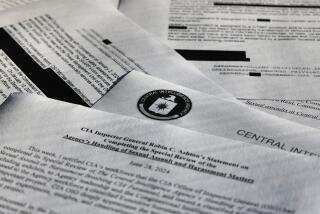CIA Bureau Seen as Conduit for KGB Information
WASHINGTON — The Soviet KGB sent “controlled information” through the CIA to U.S. presidents for years largely because the CIA’s highly secretive Soviet Division operated without the checks and balances of most other divisions, allowing several mid-level CIA officers to pass on the reports without revealing that it came from double agents, intelligence sources said Thursday.
A classified CIA damage assessment of the Aldrich H. Ames spy scandal, formally presented to Congress this week, cites Robert Lubbehusen, the retired chief of reports for the Soviet Division at CIA headquarters, as among those who failed to disclose that some of the intelligence he passed on came from double agents who were working for the Soviets, the sources said.
Lubbehusen and the others believed the information from the double agents was genuine, the sources said. They did not disclose that it came from double agents because they believed such disclosures would distract the President and other policy-makers from what the CIA officers believed was highly valuable material.
And in fact, agency officials still debate how much of the information passed on by double agents was genuine and how much was fabricated. Lubbehusen would not comment Thursday.
Intense Criticism
The agency came under intense criticism this week when CIA Director John M. Deutch disclosed that the CIA’s clandestine operations inside Russia had been riddled with double agents who passed on information from their KGB masters to the CIA for several years in the 1980s and perhaps into the 1990s.
But an even more explosive charge is that Lubbehusen and others knew that the agents were “doubled” yet continued to send the material along without qualifying the nature of the sources. The long-awaited Ames damage assessment, presented to Congress Tuesday, found that Ames had betrayed more than 100 CIA agents or potential agents inside Russia and other nations. Those agents were mainly Russians recruited by CIA officers to spy for the United States. But after Ames gave their identities to the KGB, the Soviets then forced many of them to act as double agents, with their KGB masters controlling the information that they fed back to the CIA.
Intelligence sources said that reports officers in the Soviet Division like Lubbehusen were able to get away with passing on such disinformation because they had far more authority than their counterparts anywhere else in the CIA. For example, they often knew more about the sources of their information--the Russian spies working for the CIA--than did case officers in the field in Moscow.
Because of the difficulties of conducting espionage inside Russia, case officers in Moscow often did not have much direct contact with the Russian spies working for the CIA. Instead, they would contact them indirectly and pick up their information at “dead drops”--prearranged locations for microfilm or other information to be left--and then ship it to the Langley, Va., CIA headquarters for processing by reports officers.
Those headquarters officers were thus often the first to see the raw intelligence and thus had the opportunity to describe the sources in the reports.
After the reports were approved by the chief of the Soviet Division, they would then be sent on for use by the CIA’s intelligence analysts, who had to trust the source descriptions provided by the reports officers.
What’s more, case officers back in Moscow often would not see those reports.
Checks, Balances
By contrast, in most other divisions of the CIA’s clandestine service, checks and balances exist that make it very difficult for a reports officer to hide the true identity of a double agent, sources said.
For example, a case officer dealing with sources in the field would be intimately involved in processing the eventual report by headquarters. He or she would see the “byline” on the intelligence reports--the description of the source of the information. The case officer would thus know whether the reports officer was concealing that a source was in fact a double agent.
Sources said that Lubbehusen believed that the information coming in from double agents was genuine. Under normal CIA policy, he could still pass on information from double agents, provided he attached a qualifier in the “byline” stating clearly that the information, while thought to be genuine, was coming from a double agent.
But sources said that Lubbehusen believed that such a qualifier would distract attention from the information, which he thought was important to the national security of the United States.
“I think he clearly believed that he was doing the right thing, that the information was legitimate and he didn’t want to distract attention from it” by accurately describing the source, said one intelligence source who knows Lubbehusen.
Debate continues within the CIA about how much of the information coming from the double agents was genuine. One source, stressing that Lubbehusen may have been correct in his assumption about the value of the information, said: “I don’t think it’s clear that any of this information was bad. I think it was good information used to establish the bona fides of the double agents.”
Still, the Pentagon is concerned that its purchases of military equipment may have been influenced by inflated estimates of Soviet military capabilities fed to the CIA by the double agents.
Disinformation
Deputy Defense Secretary John White has established a panel to assess whether any weapons systems were bought in a needless attempt to catch up with inflated estimates of Soviet capabilities. Sen. Arlen Specter (R-Pa.) said this week that the KGB’s disinformation campaign cost the U.S. “billions of dollars” in needless military purchases.
But several intelligence community officials and other Clinton Administration officials sought to downplay the impact on the Pentagon of the disinformation campaign. They said that the KGB disinformation may have influenced purchasing decisions, but the Pentagon draws on so many sources of information to determine its weapons needs that they find it highly unlikely that intelligence from human agents inside Russia would ever have been the sole determinant of arms purchases.
“Do you really think that the Department of Defense would buy major new weapons based solely on the word of a Russian spy? Come on,” said one Administration source.
It’s uncertain whether Lubbehusen is the highest-ranking CIA official to have engaged in the practice of knowingly passing on information from double agents without disclosing it. Several officers were involved in passing on what CIA officers call “feed information” from the Soviets, according to lawmakers and others familiar with the damage assessment and an accompanying report by CIA Inspector General Fred Hitz.
“Did others know? Of course others knew,” said one intelligence source. “People knew that there was reason to believe that the sources of the information were either known to the Soviets, and may or may not have been controlled,” said a source familiar with the case. “He [Lubbehusen] wasn’t the sole owner of that assessment.
“What’s missing is this: How can you pass that on without saying where it is coming from? That’s just plain nutty.”
Lubbehusen is said by sources to have retired in the early 1990s after a career in which he rose through the ranks to become reports chief of the Soviet Division. He is described by several former colleagues as “arrogant” and as a man intent on maintaining control over the flow of information and intelligence.
More to Read
Sign up for Essential California
The most important California stories and recommendations in your inbox every morning.
You may occasionally receive promotional content from the Los Angeles Times.










